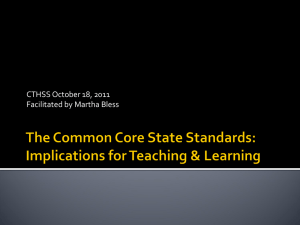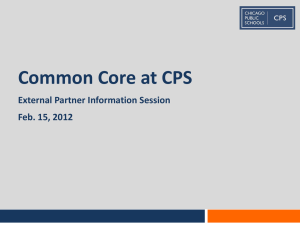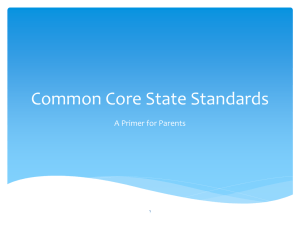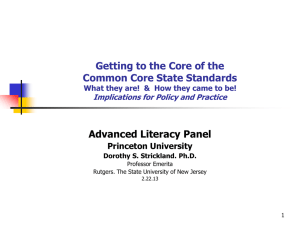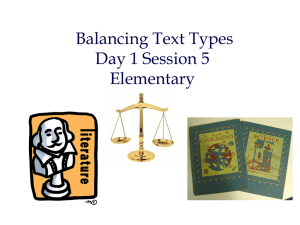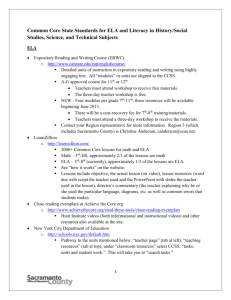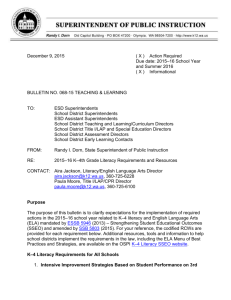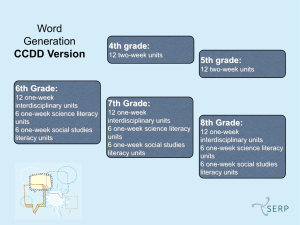Common Core Preparation PPT
advertisement
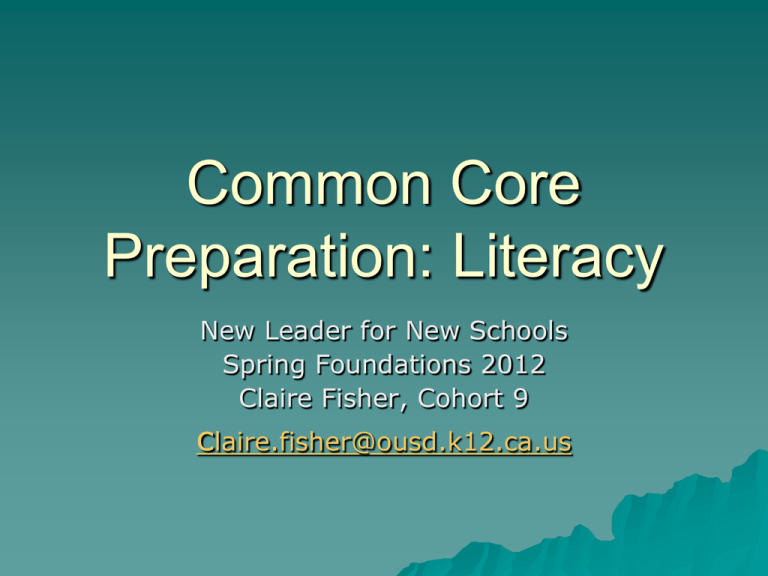
Common Core Preparation: Literacy New Leader for New Schools Spring Foundations 2012 Claire Fisher, Cohort 9 claire.fisher@ousd.k12.ca.us Do Now: Self Assessment Use the self assessment to guide you through reflecting on where your current site is in regards to implementing Common Core standards for ELA. Decide your position on the statement: My site is currently highly prepared to implement the Common Core standards. (strongly agree, agree, disagree, strongly disagree) Learning Targets Residents will be able to assess how well they are addressing Common Core skills at their current site and decide action steps to improve their literacy programs. Residents will be able to use an observation tool that gives feedback to how well classrooms are implementing Common Core. Residents will be able to identify leadership moves they can make to improve the school’s literacy plan specifically around addressing Common Core skills. Edna Brewer MS: Case Study EBMS in a nut shell: 817 students grades 6-8th grade Demographics: 35% AA, 30% Asian, 20% Latino, 5% White, 10% undeclared, 60% free and reduce lunch ELA test scores: 3% FBB, 6% BB, 22% B, 29% Pro, 23% Ad About a 30% gap between AA and White/Asian students in ELA Progression of Literacy @ EBMS Currently: Partner planning, common assessments, focused department meetings on argumentative writing Last year: Very little collaboration and unity Future: ELA and History departments collaborate, build internal toolkit for Common Core, high expectations for Partner planning Conditions for Successful Implementation Curriculum Mapping Implementation Vision + Skills + Incentives + Resources + Action Plan = Sustainable Change Skills + Incentives + Resources + Action Plan = Confusion Incentives + Resources + Action Plan = Anxiety Resources + Action Plan = Resistance Action Plan = Frustration = Treadmill Vision + Vision + Skills + Vision + Skills + Incentives + Vision + Skills + Incentives + Key Questions: Vision -- "Why are we doing this?" Skills -- "How do we build effective maps?" Incentives -- "How will mapping improve teaching and learning?" Resources Resources -- "Do we have tools, time, and training to map effectively?" Action Plan -- "Over the next three years, do we have attainable timelines and goals? Who will be the responsible parties for implementations, monitoring, and feedback?" Leadership Moves Professional Time Development (skills) structures (resources) Teacher expectations (action plan) Observations and feedback: time in classrooms (resources and skills) Professional Development Frame a new skill or strategy -have model teachers share lessons, share a video tape of a lesson, or bring the materials to share (teacher led PD is very powerful!) - give ample collaborative planning time with clear expectations for the outcome - ensure that administration or instructional supports are present during the PD in order to be part of the process - plan follow ups for the outcomes that connect the PD days (have a best practice share of the artifact they created at the previous PD) - gallery walks or other best practice shares Time Structures Time is worth more than money in schools! - think about how the teachers prep time is used and scheduled - ensure that prep time can be used as collaboration time between partner planners, department members, lead teachers with mentees, and administrators - as an administrator, plan on being present during those crucial planning times at least 1 time a week Teacher Expectations Bureaucratic - lesson plan turn in unit test results benchmarks and unit assessment results instructional guidelines Non-Bureaucratic - being present at partner planning or department meetings - regular data meetings Observations and Feedback Observations - make it into classrooms regularly (set a reasonably high expectation and then stick to it, i.e. one day a week, one hour a day) - use the checklist to look for signs of Common Core implementation - Ask students questions, look at work, move around Feedback - timely is better than perfect; give the feedback within 24 hours - focus on only 1-2 growths with really specific steps for moving forward Video: Practice Using the tool Context for the Video Overview of the Observation Tool SBAC & PARCC Two national state-based consortia are overseeing development of assessments for CCSS, with funding from Race to the Top PARCC: The Partnership for Assessment of Readiness for College and Careers SBAC: SMARTER Balanced Assessment Consortium National Consortium of States for SBAC • • • 29 states representing 48% of K-12 students 19 governing, 10 advisory states Washington state is fiscal agent PARCC States Key Elements of a Performance Tasks Real-world tasks and/or scenario-based problems Multiple approaches, points of view and interpretations Content that is relevant & meaningful to students Integration of knowledge and skills across multiple standards/strands Extended responses, research skills and complex evidence-based analysis Demonstration of knowledge and skills, including 21st century skills such as critically analyzing & synthesizing media texts Sample Assessment Dig-In • What do you notice that is similar or different from how students are currently assessed in state tests? • What key elements of a Performance Task do you see strongly reflected in this item? • What reactions and questions come up for you? Assessment Design Feature #1: Claims Claims are BROAD learning goals that group several CCSS standards into a broad statement about something a reader or writer should be able to do. Here’s an example: Claim #2: Students can produce effective writing for a range of purposes and audiences. W4: Produce clear and coherent writing… appropriate to task, purpose, and audience W1: Argumentative Writing W2: Informative/ Explanatory Writing W8 and W9: Using valid evidence W3: Narrative Writing L1 and L2: Command of Conventions Summary of Claims & ELA and Literacy CCSS Claim #1 – Students can read closely & critically to comprehend a range of increasingly complex literary and informational texts. • • • Literature: RL 1-3, 5-7, & 9 Informational text: RI 1-3, 5-9 Read/ Literacy: 1-3, 5-9 (gr 6–11) Claim #2 – Students can produce effective writing for a range of purposes and audiences. • • • Opinion / Argument (W1), Informational (W2); Narrative (W3), Writing Literacy 1-2 (gr. 6-11) Plan / Organize / Edit (W4); Language – Edit (L1, L2) Writing – Gather evidence (W8) and Draw evidence (W9) (gr 4-11) Summary of Claims & ELA and Literacy CCSS Claim #3 – Students can employ effective speaking and listening skills for a range of purposes and audiences. • • Listening (SL – 1d, 2,3) Speaking (SL – 4,5,6) Claim #4 – Students can engage appropriately in collaborative and independent inquiry to investigate / research topics, pose questions, and gather and present information. • • • Writing (W7, W8) & draw evidence: W9 (gr 4-11) Reading Literacy: 1-3, 5-9 (gr 6-11) Writing Literacy: 1-2 (gr 6-11) Summary of Claims & ELA and Literacy CCSS Claim #5 – Students can use oral and written language skillfully across range of literacy tasks. • • • Read Literature (RL4); Info (RI4); Read /Literacy: 4 (6-11) Language Use: 3,4,5 Speaking / Listening: LS1d,2,3 NOTE: This claim is “bundled with the other claims” in the assessment design, i.e. it is not assessed in isolation but in the context of reading, writing, listening and speaking. Design Feature #2: Depths of Knowledge 1-Recall and Reproduction 3-Strategic Thinking 2-Basic Application of Skills & Concepts 4-Extended Thinking Resources PARC http://www.parcconline.org/sites/parcc/files/Common_Core_Work book.pdf Smarter Balance http://www.k12.wa.us/smarter/ Urban Debate League http://www.urbandebate.org/index.shtml Close Reading http://www.fas.harvard.edu/~wricntr/documents/CloseReading.ht ml



